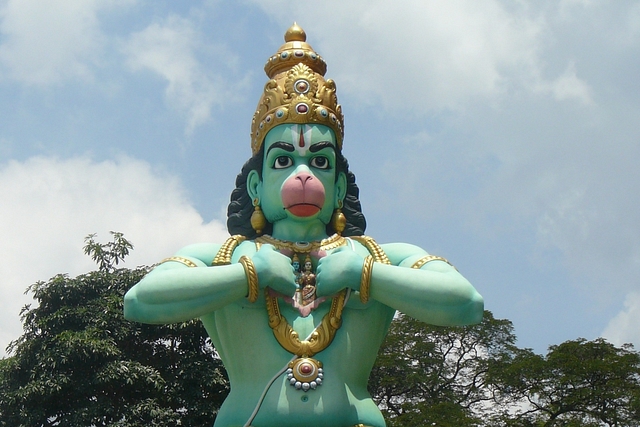Culture
Hanuman Jayanti Special: Pancha-Mukha Anjaneya And The 'Horcrux'

A Hanuman statue
In southern India, there's a fascinating folk tradition about Hanuman defeating Mayil-Ravana, also known as Ahi-Ravana or Patala-Ravana in Malayalam. In some versions, Ahi-Ravana and Mayil-Ravana are portrayed as brothers, with Ahi being the elder.
Hanuman vanquishing Mayil-Ravana is more a sacred folk tradition than a folk tale, and this tradition has given rise to one of the most revered forms of Hanuman: Pancha-Mukha Anjaneya (with five faces). Such is the tale's popularity that the very third silent movie in Tamil was based on this folk-Puranic episode.
Quite interestingly, the Mayil-Ravana story has parallels with many of the imageries of Valmiki Ramayana:
-Like Sita being abducted by Ravana, here Ram and Lakshmana are abducted by Mayil-Ravana.
-While Sita steps out of the hermitage and is abducted, here Mayil-Ravana enters the impenetrable tail-fort made by Hanuman and through spells takes Ram and Lakshmana.
-Ravana moves through the skies while Ram-Lakshmana are taken through spells to an underground city.
In the city, there is also Chandrasena, a woman who had been kidnapped by Mayil-Ravana and who had vowed to marry only Rama. Hanuman, with Chandrasena's help, locates Ram and Lakshmana, who were on the verge of being sacrificed to Kali.
The 'horcruxes'
Mayil Ravana has his vital energy infused into five beetles which are kept in a small chest, guarded by fierce poisonous serpents inside a cave.
To kill Mayil-Ravana, all five beetles have to be killed at once.
So, even as Ram and Lakshmana battle Mayil-Ravana, who could not be killed unless the beetles are, Hanuman sets forth to find them.
He discovers them and gets the chest. But how to kill them all at once?
Hanuman now takes the form of Pancha-Mukha Anjaneya – the face of Hanuman, Garuda (eagle), Varaha (boar), Narasimha (lion) and Hayagriva (horse).
When the box is opened, all the faces draw in air forcefully. The beetles get pulled towards Hanuman who immediately and simultaneously kills them.
At the same moment, the arrow of Shri Ram penetrates Mayil-Ravana, marking his end.
Chandrasena, who provided Hanuman with the information on Mayil-Ravana's mortality, had also requested to see Shri Ram in person. When Ram and Chandrasena meet, Ramaclarifies that he will not touch another woman, and Chandrasena attains liberation.
It's noteworthy that Hanuman, witnessing Sita's suffering, had volunteered to bring her back to Ram, but Sita declined. In this tradition though, Hanuman's desire is fulfilled as he rescues not Sita but Ram and Lakshmana from Mayil-Ravana's den.
How do we understand the emergence of the Mayil-Ravana story in southern India?
Hanuman bhakti became a widespread social phenomenon with Vijayanagara's resistance to the Islamist colonisation. Hanuman began to take a vishwarupa in the bhakti-field of southern India. The canvas became larger.
Hanuman the bhakta also is Hanuman the Para-Brahman. Hanuman is the devotee and Hanuman is the sacred warrior. He has in Him Garuda – not only the vahana of Vishnu but the bringer of nectar in Vedic literature. He has in Him Varaha and Narasimha – avataras of Vishnu Himself. And He has in Him Hayagriva, the Lord of Wisdom in the Sri Vaishnava tradition.
He embodies even more explicitly strength, devotion, and divine wisdom.
Hanuman vanquishing Mayil-Ravana is thus more than a localised folk-tradition. Through the Pancha-Mukha Anjaneya form, that story has become a major component of Hanuman worship.
This is how Hindu Dharma shows its vitality. Through local dramas, puppet shows, poetic renderings, Pancha-Mukha Hanuman becomes the most venerated form of Hanuman in many regions today.
The story of Pancha-Mukha Hanuman bringing an end to Mayil-Ravana is even more relevant today. Even as the Hindu civilisation battles Mayil-Ravana in contemporary battle fields, horcruxes have to be found and destroyed.
One cannot employ mono-form or a singular method here. The emergence of five divine faces from Hanuman symbolizes different attributes: Garuda represents obedience and strength; Hanuman's face embodies both bhakti and valour; Narasimha portrays fierceness and strength; Varaha symbolizes the strength to uplift the submerged; and the face of Hayagriva signifies wisdom. Our society needs to manifest all these qualities to battle the Mayil-Ravana we face at various levels and in various forms.
Support Swarajya's 50 Ground Reports Project & Sponsor A Story
Every general election Swarajya does a 50 ground reports project.
Aimed only at serious readers and those who appreciate the nuances of political undercurrents, the project provides a sense of India's electoral landscape. As you know, these reports are produced after considerable investment of travel, time and effort on the ground.
This time too we've kicked off the project in style and have covered over 30 constituencies already. If you're someone who appreciates such work and have enjoyed our coverage please consider sponsoring a ground report for just Rs 2999 to Rs 19,999 - it goes a long way in helping us produce more quality reportage.
You can also back this project by becoming a subscriber for as little as Rs 999 - so do click on this links and choose a plan that suits you and back us.
Click below to contribute.
Latest